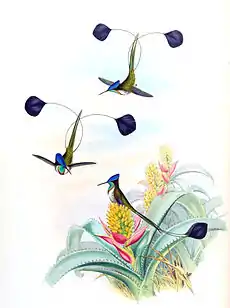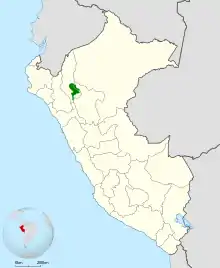Marvelous spatuletail
The marvelous spatuletail (Loddigesia mirabilis) is a medium-sized (up to 15 cm long) white, green and bronze hummingbird adorned with blue crest feathers, a brilliant turquoise gorget, and a black line on its white underparts. It is the only member of the genus Loddigesia. It is sexually dimorphic.
| Marvelous spatuletail | |
|---|---|
 | |
| Loddigesia mirabilis by John Gould | |
| Scientific classification | |
| Kingdom: | Animalia |
| Phylum: | Chordata |
| Class: | Aves |
| Order: | Apodiformes |
| Family: | Trochilidae |
| Genus: | Loddigesia Bonaparte, 1850 |
| Species: | L. mirabilis |
| Binomial name | |
| Loddigesia mirabilis (Bourcier, 1847) | |
 | |
| Distribution of Loddigesia mirabilis in Peru | |
A molecular phylogenetic study of the hummingbirds published in 2014 found that the marvelous spatuletail was embedded in the genus Eriocnemis containing "pufflegs" making Eriocnemis polyphyletic.[2]
A Peruvian endemic, this species is found on forest edges in the Río Utcubamba region. It was first reported in 1835 by the bird collector Andrew Matthews for George Loddiges, after whom the genus is named.
The marvelous spatuletail is unique among birds in having just four feathers in its tail. Its most remarkable feature is the male's two long racquet-shaped outer tail feathers that cross each other and end in large violet-blue discs or "spatules". He can move them independently.
Due to habitat loss, small population size, and limited range, the marvelous spatuletail is evaluated as Endangered on the IUCN Red List of Threatened Species.[1] It is listed on Appendix II of CITES.
In 2006, American Bird Conservancy provided Peruvian conservation partner ECOAN with support to sign a conservation easement with the Pomacochas Community to protect and manage about 100 acres (0.40 km2) of significant habitat for the marvelous spatuletail. Over 30,000 saplings of native trees and bushes have been planted there for the marvelous spatuletail. This conservation easement is the first of its kind in Peru.[3][4]
The marvelous spatuletail has been featured on the PBS TV series Nature[5] and the BBC TV series Natural World.[6]
References
- BirdLife International (2012). "Loddigesia mirabilis". IUCN Red List of Threatened Species. 2012. Retrieved 26 November 2013.CS1 maint: ref=harv (link)
- McGuire, J.; Witt, C.; Remsen, J.V.; Corl, A.; Rabosky, D.; Altshuler, D.; Dudley, R. (2014). "Molecular phylogenetics and the diversification of hummingbirds". Current Biology. 24 (8): 910–916. doi:10.1016/j.cub.2014.03.016.
- "A marvellous hummingbird display". 3 November 2009. Retrieved 20 July 2020.
- "Marvelous Spatuletail Hummingbird | Huembo | ECOAN | Photography". hummingbirdspot. Retrieved 20 July 2020.
- Nature episode "Hummingbirds: Magic in the Air", 10 January 2010.
- Natural World Episode 5. "Attenborough's Ark: Natural World Special", 9 November 2012
External links
| Wikimedia Commons has media related to Loddigesia mirabilis. |
- Marvellous Spatuletail videos on the Internet Bird Collection
- BirdLife Species Factsheet
- Marvelous Spatuletail photo gallery at VIREO including this high-resolution photo
- Spatuletail video at the BBC
